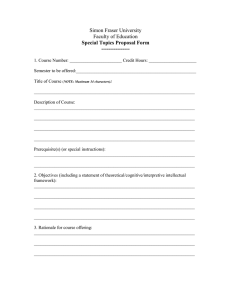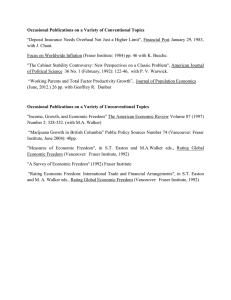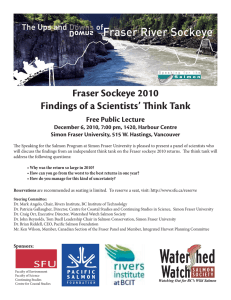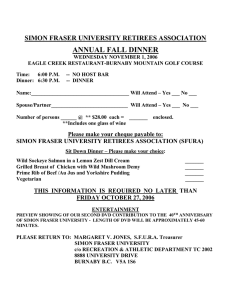SANDY FRASER CONTEMPORARY PAINTING HIGHER STILL RESOURCE Art & Design Studies
advertisement
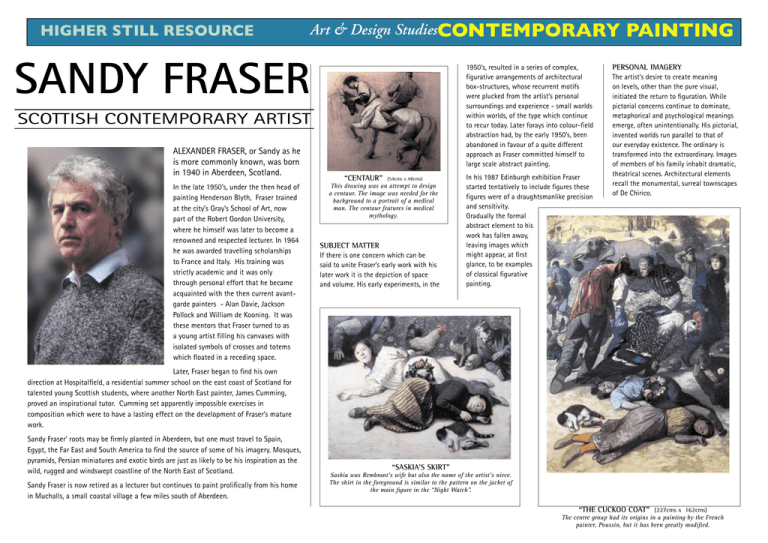
HIGHER STILL RESOURCE Art & Design StudiesCONTEMPORARY SANDY FRASER 1950’s, resulted in a series of complex, figurative arrangements of architectural box-structures, whose recurrent motifs were plucked from the artist’s personal surroundings and experience - small worlds within worlds, of the type which continue to recur today. Later forays into colour-field abstraction had, by the early 1950’s, been abandoned in favour of a quite different approach as Fraser committed himself to large scale abstract painting. SCOTTISH CONTEMPORARY ARTIST ALEXANDER FRASER, or Sandy as he is more commonly known, was born in 1940 in Aberdeen, Scotland. In the late 1950’s, under the then head of painting Henderson Blyth, Fraser trained at the city’s Gray’s School of Art, now part of the Robert Gordon University, where he himself was later to become a renowned and respected lecturer. In 1964 he was awarded travelling scholarships to France and Italy. His training was strictly academic and it was only through personal effort that he became acquainted with the then current avantgarde painters - Alan Davie, Jackson Pollock and William de Kooning. It was these mentors that Fraser turned to as a young artist filling his canvases with isolated symbols of crosses and totems which floated in a receding space. “CENTAUR” (54cms x 48cms) This drawing was an attempt to design a centaur. The image was needed for the background to a portrait of a medical man. The centaur features in medical mythology. SUBJECT MATTER If there is one concern which can be said to unite Fraser’s early work with his later work it is the depiction of space and volume. His early experiments, in the In his 1987 Edinburgh exhibition Fraser started tentatively to include figures these figures were of a draughtsmanlike precision and sensitivity. Gradually the formal abstract element to his work has fallen away, leaving images which might appear, at first glance, to be examples of classical figurative painting. PAINTING PERSONAL IMAGERY The artist’s desire to create meaning on levels, other than the pure visual, initiated the return to figuration. While pictorial concerns continue to dominate, metaphorical and psychological meanings emerge, often unintentionally. His pictorial, invented worlds run parallel to that of our everyday existence. The ordinary is transformed into the extraordinary. Images of members of his family inhabit dramatic, theatrical scenes. Architectural elements recall the monumental, surreal townscapes of De Chirico. Later, Fraser began to find his own direction at Hospitalfield, a residential summer school on the east coast of Scotland for talented young Scottish students, where another North East painter, James Cumming, proved an inspirational tutor. Cumming set apparently impossible exercises in composition which were to have a lasting effect on the development of Fraser’s mature work. Sandy Fraser’ roots may be firmly planted in Aberdeen, but one must travel to Spain, Egypt, the Far East and South America to find the source of some of his imagery. Mosques, pyramids, Persian miniatures and exotic birds are just as likely to be his inspiration as the wild, rugged and windswept coastline of the North East of Scotland. Sandy Fraser is now retired as a lecturer but continues to paint prolifically from his home in Muchalls, a small coastal village a few miles south of Aberdeen. “SASKIA’S SKIRT” Saskia was Rembrant’s wife but also the name of the artist’s niece. The shirt in the foreground is similar to the pattern on the jacket of the main figure in the “Night Watch”. “THE CUCKOO COAT” (227cms x 162cms) The centre group had its origins in a painting by the French painter, Poussin, but it has been greatly modified. HIGHER STILL RESOURCE TECHNIQUE In the 1980’s his approach to his paintings was bold, making big sweeping strokes of a heavily laden wide brush, using paint straight from the can. The canvases were painted laid on the floor. The action technique might have drawn on Fraser’s early predilection for Pollock and Davie. In his latest work his early abstract has been replaced by work of draughtasmanlike precision and sensitivity, painting mainly with oil on canvas Fraser draws on studies and sketches he has made in the past - some as old as ten or twenty years. These he will expand upon and place in the picture plane, gradually Art & Design StudiesCONTEMPORARY working up a composition which is at the heart, initially at least, concerned with abstract shapes. “MUCHALLS GATHERING WITH SIAMESE FIREBACK” IDEAS, FEELING & MOOD Fraser’s paintings work with their weird atmosphere created by the lack of a real interrelation of individual figures who seem to habit their own private worlds. Mysterious, threatening and often possibly heroic figure take centre stage. Fraser is using the landscape and physical presence of the familiar to create his own mythical work, a world where abstraction and figuration coexist in the language of paint on canvas. The exotic pheasant at centre left is the Siamese Fireback - it was seen in Laos. The dog in the foreground was drawn in Thailand and the distant background is a remembered scene in Rajastan, India. They are brought together to create a new world. PAINTING (195cms x 195cms) “PUBLIC ART” Although invented, the buildings refer to North Africa or India where wall decoration is common. It allows the artist to incorporate different styles of representation in one picture. The main figure wears a feathered coat. Feathered garments have been seen by the artist in Peru, Nepal and Mexico. “MUCHALLS GARLAND” (135cms x 108cms) The figures are arranged in a circle, like the garland on the woman’s head. The chequered rug is used to establish the spacial relationship between figures (like the black & white grid, common in Italian and Dutch painting). The village of Muchalls is seen in the background and includes the artist’s house. “HELEN JANE FRASER” (140cms X 140cms) The screen of flowers separate the foreground from the background - the sitter likes flowers. The artist contrasts real flowers with printed flowers - garden flowers with weeds - growing flowers with catflowers. The sitter appears four times. “COAT and COLLIE” (75cms x 86cms) The architectural structure is reminiscent of Indian or Nepalese ceremonial ghats. Note the repetition of the circles.
